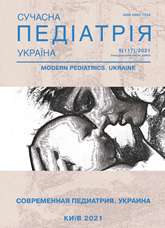Difficulties in selecting specific therapy in severe forms of congenital cytomegalovirus infection: view through time
DOI:
https://doi.org/10.15574/SP.2021.117.82Keywords:
congenital cytomegalovirus infection, severe forms, treatment, acyclovir, ganciclovirAbstract
The aim — to show the feasibility of using ganciclovir for congenital cytomegalovirus infection (CMVI) by demonstrating two clinical cases.
Clinical cases. Over time, the approaches to the treatment of congenital CMVI have changed from the use of acyclovir to the appointment of ganciclovir.
In 2011, a premature baby was diagnosed with congenital CMVI based on the presence of multiple organ lesions (lungs, liver, spleen, pancreas, eyes, central nervous system) and positive result of CMV PCR test in blood, urine and cerebrospinal fluid. Only acyclovir was used as an etiotropic drug due to the lack of evidence at that time on the safety of another antiviral drug — ganciclovir. Treatment was not completely effective: in the follow;up at the age of two the child has a grave violation hearing and vision and profound disability due to the residual effects on the central nervous system.
In 2019, a newborn child with severe haemorrhagic syndrome, respiratory disorders and neurological symptoms was diagnosed with congenital CMVI by positive result of CMV PCR test and ganciclovir was prescribed at a dose of 6 mg/kg every 12 hours by an intravenous infusion under the control of a routine complete blood count (CBC) test. On the second week of treatment, positive dynamics was observed clinically, on the 6th week — negative result of CMV PCR test. The child was discharged on day 70th of treatment without residual effects on the central nervous system. At the age of 9 months, deafness of 2–3 degrees was diagnosed, but prosthetics were performed timely with complete restoration of hearing. At age of 12 month this child sits, rolls over, crawls; responds adequately to others; captures the gaze and keep an eye on items.
Conclusions. Two clinical cases through the description of changes in approaches to specific therapy of congenital cytomegalovirus disease from acyclovir to ganciclovir and a clear demonstration of the difference in disease outcomes — from severe disability when ganciclovir was not prescribed, to complete rehabilitation with its use demonstrate the feasibility of prescribing ganciclovir.
The research was carried out in accordance with the principles of the Helsinki Declaration. The informed consent of the patient was obtained for conducting the studies.
No conflict of interest was declared by the authors.
References
Artsiomchyk TA. (2012). Сongenital cytomegalovirus infection. Silent threat. Minsk: BSMU: 12.
Boppana SB, Ross SA, Shimamura M, Palmer AL, Ahmed A, Michaels MG et al. (2011). Saliva polymerase-chain-reaction assay for cytomegalovirus screening in newborns. N Engl J Med. 364: 2111-2118. https://doi.org/10.1056/NEJMoa1006561; PMid:21631323 PMCid:PMC3153859
Britt WJ. (2017). Congenital Human Cytomegalovirus Infection and the Enigma of Maternal Immunity. J Virol. 91 (15): e02392-16. https://doi.org/10.1128/JVI.02392-16
Cantey JB. (2018). Neonatal Infections. Pathophysiology, Diagnosis, and Management. Springer. 255. https://doi.org/10.1007/978-3-319-90038-4
Coleman JL, Steele R. (2017). Preventing Congenital Cytomegalovirus Infection. Clin Pediatr (Phila). 12: 1085-1094. https://doi.org/10.1177/0009922817724400; PMid:28825308
Fesenko ME, Melashchenko EI. (2012). The morbidity, physical and neuropsychic development children with congenital cytomegalovirus infection. Sovremennaya pediatriya. 3 (43): 42-44.
Forner G, Abate D, Mengoli C, Palu G, Gussetti N. (2015). High Cytomegalovirus (CMV) DNAemia Predicts CMV Sequelae in Asymptomatic Congenitally Infected Newborns Born to Women With Primary Infection During Pregnancy. J Infect Dis. 212: 67-71. https://doi.org/10.1093/infdis/jiu627; PMid:25387583
Kawai K, Itoh H. (2018). Congenital Cytomegalovirus Infection. N Engl J Med. 379 (13): 21. https://doi.org/10.1056/NEJMicm1800262; PMid:30257153
Kimberlin DW, Jester PM, Sanchez PJ, Ahmed A, AravBoger R, Michaels MG et al. (2015). Valganciclovir for Symptomatic Congenital Cytomegalovirus Disease. N Engl J Med. 372: 933-943. https://doi.org/10.1056/NEJMoa1404599; PMid:25738669 PMCid:PMC4401811
Kompendium. (2021). Gantsiklovir-Farmeks. Farmeks Grupp. URL: https://compendium.com.ua/info/251962/gantsiklovir-farmeks/.
Luck SE, Wieringa JW, Blazquez-Gamero D, Henneke P et al. (2017). ESPID Congenital CMV Group Meeting. Congenital Cytomegalovirus: A European Expert Consensus Statement on Diagnosis and Management. Pediatr Infect Dis J Dec. 36 (12): 1205-1213. https://doi.org/10.1097/INF.0000000000001763; PMid:29140947
Medzhidova MG. (2005). Vyjavlenie markerov citomegalovirusa u novorozhdennyh i detej rannego vozrasta. Razvitie apoptoza pri citomegalovirusnoj infekcii: avtoref. dis. kandidata biologicheskih nauk. М: GU NII virusologii im. D.I. Ivanovskogo: 28.
Nigro G. (2017). Hyperimmune globulin in pregnancy for the prevention of congenital cytomegalovirus disease. Expert Rev Anti Infect Ther. 15 (11): 977-986. https://doi.org/10.1080/14787210.2017.1398081; PMid:29072089
Nishida K, Morioka I, Nakamachi Y, Kobayashi Y, Imanishi T, Kawano S et al. (2015). Neurological outcomes in symptomatic congenital cytomegalovirus-infected infants after introduction of newborn urine screening and antiviral treatment. Brain Dev. https://doi.org/10.1016/j.braindev.2015.08.003; PMid:26282917
Swanson EC, Schleiss MR. (2013). Congenital Cytomegalovirus Infection: New Prospects for Prevention and Therapy. Pediatr Clin North Am. 60 (2): 335-349. https://doi.org/10.1016/j.pcl.2012.12.008; PMid:23481104 PMCid:PMC3807860
Vossen A, de Vries J, van der Zeijst B. (2009). The 2008 congenital cytomegalovirus conference; 5-7 november, centers for disease control and prevention, Atlanta: Eurosurveillance: 1-2. https://doi.org/10.2807/ese.14.09.19136-en
Yulish YeI. (2015). Cytomegalovirus infection in children: treatment approaches in different course of infection. Child's health. 4 (64): 11-18. https://doi.org/10.22141/2224-0551.4.64.2015.75239
Downloads
Published
Issue
Section
License
Copyright (c) 2021 Modern pediatrics. Ukraine

This work is licensed under a Creative Commons Attribution-NonCommercial 4.0 International License.
The policy of the Journal “MODERN PEDIATRICS. UKRAINE” is compatible with the vast majority of funders' of open access and self-archiving policies. The journal provides immediate open access route being convinced that everyone – not only scientists - can benefit from research results, and publishes articles exclusively under open access distribution, with a Creative Commons Attribution-Noncommercial 4.0 international license (СС BY-NC).
Authors transfer the copyright to the Journal “MODERN PEDIATRICS. UKRAINE” when the manuscript is accepted for publication. Authors declare that this manuscript has not been published nor is under simultaneous consideration for publication elsewhere. After publication, the articles become freely available on-line to the public.
Readers have the right to use, distribute, and reproduce articles in any medium, provided the articles and the journal are properly cited.
The use of published materials for commercial purposes is strongly prohibited.

